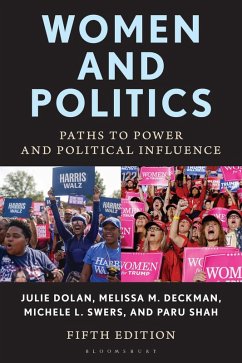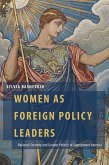Julie Dolan, Melissa M. Deckman, Michele L. Swers, Paru Shah
Women and Politics (eBook, ePUB)
Paths to Power and Political Influence
37,95 €
37,95 €
inkl. MwSt.
Sofort per Download lieferbar

19 °P sammeln
37,95 €
Als Download kaufen

37,95 €
inkl. MwSt.
Sofort per Download lieferbar

19 °P sammeln
Jetzt verschenken
Alle Infos zum eBook verschenken
37,95 €
inkl. MwSt.
Sofort per Download lieferbar
Alle Infos zum eBook verschenken

19 °P sammeln
Julie Dolan, Melissa M. Deckman, Michele L. Swers, Paru Shah
Women and Politics (eBook, ePUB)
Paths to Power and Political Influence
- Format: ePub
- Merkliste
- Auf die Merkliste
- Bewerten Bewerten
- Teilen
- Produkt teilen
- Produkterinnerung
- Produkterinnerung
- Weitere 6 Ausgaben:
- Gebundenes Buch
- Gebundenes Buch
- Broschiertes Buch
- Broschiertes Buch
- eBook, ePUB
- eBook, PDF

Bitte loggen Sie sich zunächst in Ihr Kundenkonto ein oder registrieren Sie sich bei
bücher.de, um das eBook-Abo tolino select nutzen zu können.
Hier können Sie sich einloggen
Hier können Sie sich einloggen
Sie sind bereits eingeloggt. Klicken Sie auf 2. tolino select Abo, um fortzufahren.

Bitte loggen Sie sich zunächst in Ihr Kundenkonto ein oder registrieren Sie sich bei bücher.de, um das eBook-Abo tolino select nutzen zu können.
Women and Politics: Paths to Power and Political Influence examines the role of women in politics from the early women's movement to the female politicians in power today. Focusing on women whose stories have not yet been told, this book includes new analysis and scholarship on the experiences and viewpoints of conservative women, women of color, LGBT women, and millennial women. Students will gain historical insight into how women have achieved political power and how they have influenced the American political system at the state, local, and national levels, in each branch of government.…mehr
- Geräte: eReader
- mit Kopierschutz
- eBook Hilfe
- Größe: 8.67MB
Andere Kunden interessierten sich auch für
![Michelle Obama and the FLOTUS Effect (eBook, ePUB) Michelle Obama and the FLOTUS Effect (eBook, ePUB)]() Michelle Obama and the FLOTUS Effect (eBook, ePUB)28,95 €
Michelle Obama and the FLOTUS Effect (eBook, ePUB)28,95 €![Women of the 2016 Election (eBook, ePUB) Women of the 2016 Election (eBook, ePUB)]() Women of the 2016 Election (eBook, ePUB)30,95 €
Women of the 2016 Election (eBook, ePUB)30,95 €![Gendered Politics (eBook, ePUB) Gendered Politics (eBook, ePUB)]() Linda van IngenGendered Politics (eBook, ePUB)30,95 €
Linda van IngenGendered Politics (eBook, ePUB)30,95 €![Women as Foreign Policy Leaders (eBook, ePUB) Women as Foreign Policy Leaders (eBook, ePUB)]() Sylvia BashevkinWomen as Foreign Policy Leaders (eBook, ePUB)15,95 €
Sylvia BashevkinWomen as Foreign Policy Leaders (eBook, ePUB)15,95 €![Latinas in American Politics (eBook, ePUB) Latinas in American Politics (eBook, ePUB)]() Latinas in American Politics (eBook, ePUB)36,95 €
Latinas in American Politics (eBook, ePUB)36,95 €![Women, Politics, and Power (eBook, ePUB) Women, Politics, and Power (eBook, ePUB)]() Pamela PaxtonWomen, Politics, and Power (eBook, ePUB)39,95 €
Pamela PaxtonWomen, Politics, and Power (eBook, ePUB)39,95 €![The Hillary Effect: Perspectives on Clinton's Legacy (eBook, ePUB) The Hillary Effect: Perspectives on Clinton's Legacy (eBook, ePUB)]() The Hillary Effect: Perspectives on Clinton's Legacy (eBook, ePUB)18,95 €
The Hillary Effect: Perspectives on Clinton's Legacy (eBook, ePUB)18,95 €-
-
-
Women and Politics: Paths to Power and Political Influence examines the role of women in politics from the early women's movement to the female politicians in power today. Focusing on women whose stories have not yet been told, this book includes new analysis and scholarship on the experiences and viewpoints of conservative women, women of color, LGBT women, and millennial women. Students will gain historical insight into how women have achieved political power and how they have influenced the American political system at the state, local, and national levels, in each branch of government. Engaging profiles of the key players who have shaped our political system are interwoven with an analysis of the most recent election data to provide a comprehensive and unbiased introduction to the study of women and politics.
Produktdetails
- Produktdetails
- Verlag: Bloomsbury eBooks US
- Seitenzahl: 384
- Erscheinungstermin: 26. August 2025
- Englisch
- ISBN-13: 9781538178607
- Artikelnr.: 75247818
- Verlag: Bloomsbury eBooks US
- Seitenzahl: 384
- Erscheinungstermin: 26. August 2025
- Englisch
- ISBN-13: 9781538178607
- Artikelnr.: 75247818
- Herstellerkennzeichnung Die Herstellerinformationen sind derzeit nicht verfügbar.
Julie Dolan is Professor of Political Science at Macalester College in St. Paul, Minnesota. She earned her PhD from American University. Her scholarly interests include American government and politics, women and politics, and bureaucratic politics. She has received a number of prestigious awards for her scholarship and publishes in a variety of journals including Women & Politics, Public Administration Review, PS: Political Science and Politics, the Journal of Public Administration Research and Theory. Her most recent research focuses on issues of political representation in the bureaucracy.
List of Figures and Tables ix
Preface: Updated 4th Edition xi
Acknowledgments xxxi
About the Authors xxxv
1 Introduction and Theoretical Framework 1
History and Women's Political Interests 3
Women's Representation 7
PART I: WOMEN'S PATHS TO POWER
2 Women's Paths to Power 13
Women in Social Movements and Interest Groups 13
Early Women Activists and the Fight For Suffrage 14
Feminism, the Second Wave (1960s-Present) 22
The Rebirth of the Feminist Movement 23
The Emergence of the Older and Younger Branches of the
Feminist Movement 25
The Equal Rights Amendment 32
Women and Interest Groups 37
Conservative Women's Groups Fight Back 42
Reinvigoration of the Feminist Movement and Conservative
Women's Activism 45
Conclusion 53
3 The Gender Gap in Elections and Public Opinion 55
Courting the Women's Vote: The Early Years 56
The Emergence of the Modern Gender Gap 59
The Gender Gaps: Voting Trends Across Different Groups of
Women 65
Issues That Explain the Gender Gap 68
Women's Vote in a Competitive Political Climate 72
Does the Gender Gap Bring Women Political Power? 83
Do Women Vote for Women? 86
Hillary Clinton and the Women's Vote 89
Conclusion 94
4 Gender and the Decision to Run for Office 97
A Confidence Gap: Women Underestimate Their Political Abilities 101
Political Parties' Efforts to Incorporate Women 105
Family Constraints 113
Symbolic Representation: Does It Matter Whether Women Run
for Office? 115
Conclusion 120
5 Women on the Campaign Trail 123
Challenges on the Campaign Trail 127
Voter Stereotypes about Female Candidates 128
Media Coverage of Female Candidates 135
Female Presidential and Vice Presidential Candidates 140
Navigating Gender on the Campaign Trail: The 2016 Elections 143
Conclusion 156
PART II: WOMEN IN POWER
6 Women in Local Politics and Government 159
Descriptive Representation: Women Serving in Local Government 163
The Numbers: Women as Mayors and Local Executives 165
The Numbers: Women on City and Council Councils 169
The Numbers: Women Serving as School Board Members,
Clerks, Sheriffs, and Other Local Officers 171
What Determines Women's Representation in Such Offices? 174
Local Office as Stepping-stones: Filling the Pipeline? 180
Substantive Representation: Does Having Women in Local
Government Matter? 181
Women as Political Actors Outside of Government 188
Conclusion 194
7 Women in Congress and the State Legislatures 197
Women and Representation 198
Women's Representation in Legislative Bodies across the World 201
Women's Representation in Congress and the State
Legislatures across Time 204
The Advancement of Women in Congress 208
Women in Congress and State Legislatures: A Distinctive
Impact on Policy? 218
Party, Ideology, and Constituent Interests 221
Race, Ethnicity, and Social Class 225
Institutional Position 228
Gender, Race, and Institutional Norms 232
Critical Mass and Policy Influence 233
Women in Leadership 235
Conclusion 239
8 Women in the Executive Branch 241
Women's Access to the Executive Branch: Masculinity, Power,
and the Executive Branch 243
Descriptive Representation 246
Presidential and Gubernatorial Cabinets 251
Linking Descriptive and Substantive Representation: Do
Women Make a Difference? 257
Challenges to Providing Substantive Representation 261
Power and Leadership Style 265
Conclusion 267
9 Women in the Judiciary 269
Why the Courts Are Important 272
Women in the Judiciary 274
Women on the Supreme Court 278
O'Connor, Ginsburg, and Beyond: Gender and the Supreme Court 282
Women in the State Judiciary 290
The Difference Women Judges Make 296
Do Women Judges Use A "Different Voice"? 297
Empirical Studies: The Impact of Sex on Jurisprudence 300
Gender and the Supreme Court: Why Gender Matters 304
Beyond the Essentialist Argument: Why Gender Still Matters 307
Conclusion 309
Appendix A: "Declaration of Sentiments" and "Resolutions"
Adopted by the Seneca Falls Convention of 1848 311
Appendix B: National Organization for Women's Bill of Rights
and Redstockings Manifesto 315
References 319
Index 385
Preface: Updated 4th Edition xi
Acknowledgments xxxi
About the Authors xxxv
1 Introduction and Theoretical Framework 1
History and Women's Political Interests 3
Women's Representation 7
PART I: WOMEN'S PATHS TO POWER
2 Women's Paths to Power 13
Women in Social Movements and Interest Groups 13
Early Women Activists and the Fight For Suffrage 14
Feminism, the Second Wave (1960s-Present) 22
The Rebirth of the Feminist Movement 23
The Emergence of the Older and Younger Branches of the
Feminist Movement 25
The Equal Rights Amendment 32
Women and Interest Groups 37
Conservative Women's Groups Fight Back 42
Reinvigoration of the Feminist Movement and Conservative
Women's Activism 45
Conclusion 53
3 The Gender Gap in Elections and Public Opinion 55
Courting the Women's Vote: The Early Years 56
The Emergence of the Modern Gender Gap 59
The Gender Gaps: Voting Trends Across Different Groups of
Women 65
Issues That Explain the Gender Gap 68
Women's Vote in a Competitive Political Climate 72
Does the Gender Gap Bring Women Political Power? 83
Do Women Vote for Women? 86
Hillary Clinton and the Women's Vote 89
Conclusion 94
4 Gender and the Decision to Run for Office 97
A Confidence Gap: Women Underestimate Their Political Abilities 101
Political Parties' Efforts to Incorporate Women 105
Family Constraints 113
Symbolic Representation: Does It Matter Whether Women Run
for Office? 115
Conclusion 120
5 Women on the Campaign Trail 123
Challenges on the Campaign Trail 127
Voter Stereotypes about Female Candidates 128
Media Coverage of Female Candidates 135
Female Presidential and Vice Presidential Candidates 140
Navigating Gender on the Campaign Trail: The 2016 Elections 143
Conclusion 156
PART II: WOMEN IN POWER
6 Women in Local Politics and Government 159
Descriptive Representation: Women Serving in Local Government 163
The Numbers: Women as Mayors and Local Executives 165
The Numbers: Women on City and Council Councils 169
The Numbers: Women Serving as School Board Members,
Clerks, Sheriffs, and Other Local Officers 171
What Determines Women's Representation in Such Offices? 174
Local Office as Stepping-stones: Filling the Pipeline? 180
Substantive Representation: Does Having Women in Local
Government Matter? 181
Women as Political Actors Outside of Government 188
Conclusion 194
7 Women in Congress and the State Legislatures 197
Women and Representation 198
Women's Representation in Legislative Bodies across the World 201
Women's Representation in Congress and the State
Legislatures across Time 204
The Advancement of Women in Congress 208
Women in Congress and State Legislatures: A Distinctive
Impact on Policy? 218
Party, Ideology, and Constituent Interests 221
Race, Ethnicity, and Social Class 225
Institutional Position 228
Gender, Race, and Institutional Norms 232
Critical Mass and Policy Influence 233
Women in Leadership 235
Conclusion 239
8 Women in the Executive Branch 241
Women's Access to the Executive Branch: Masculinity, Power,
and the Executive Branch 243
Descriptive Representation 246
Presidential and Gubernatorial Cabinets 251
Linking Descriptive and Substantive Representation: Do
Women Make a Difference? 257
Challenges to Providing Substantive Representation 261
Power and Leadership Style 265
Conclusion 267
9 Women in the Judiciary 269
Why the Courts Are Important 272
Women in the Judiciary 274
Women on the Supreme Court 278
O'Connor, Ginsburg, and Beyond: Gender and the Supreme Court 282
Women in the State Judiciary 290
The Difference Women Judges Make 296
Do Women Judges Use A "Different Voice"? 297
Empirical Studies: The Impact of Sex on Jurisprudence 300
Gender and the Supreme Court: Why Gender Matters 304
Beyond the Essentialist Argument: Why Gender Still Matters 307
Conclusion 309
Appendix A: "Declaration of Sentiments" and "Resolutions"
Adopted by the Seneca Falls Convention of 1848 311
Appendix B: National Organization for Women's Bill of Rights
and Redstockings Manifesto 315
References 319
Index 385
List of Figures and Tables ix
Preface: Updated 4th Edition xi
Acknowledgments xxxi
About the Authors xxxv
1 Introduction and Theoretical Framework 1
History and Women's Political Interests 3
Women's Representation 7
PART I: WOMEN'S PATHS TO POWER
2 Women's Paths to Power 13
Women in Social Movements and Interest Groups 13
Early Women Activists and the Fight For Suffrage 14
Feminism, the Second Wave (1960s-Present) 22
The Rebirth of the Feminist Movement 23
The Emergence of the Older and Younger Branches of the
Feminist Movement 25
The Equal Rights Amendment 32
Women and Interest Groups 37
Conservative Women's Groups Fight Back 42
Reinvigoration of the Feminist Movement and Conservative
Women's Activism 45
Conclusion 53
3 The Gender Gap in Elections and Public Opinion 55
Courting the Women's Vote: The Early Years 56
The Emergence of the Modern Gender Gap 59
The Gender Gaps: Voting Trends Across Different Groups of
Women 65
Issues That Explain the Gender Gap 68
Women's Vote in a Competitive Political Climate 72
Does the Gender Gap Bring Women Political Power? 83
Do Women Vote for Women? 86
Hillary Clinton and the Women's Vote 89
Conclusion 94
4 Gender and the Decision to Run for Office 97
A Confidence Gap: Women Underestimate Their Political Abilities 101
Political Parties' Efforts to Incorporate Women 105
Family Constraints 113
Symbolic Representation: Does It Matter Whether Women Run
for Office? 115
Conclusion 120
5 Women on the Campaign Trail 123
Challenges on the Campaign Trail 127
Voter Stereotypes about Female Candidates 128
Media Coverage of Female Candidates 135
Female Presidential and Vice Presidential Candidates 140
Navigating Gender on the Campaign Trail: The 2016 Elections 143
Conclusion 156
PART II: WOMEN IN POWER
6 Women in Local Politics and Government 159
Descriptive Representation: Women Serving in Local Government 163
The Numbers: Women as Mayors and Local Executives 165
The Numbers: Women on City and Council Councils 169
The Numbers: Women Serving as School Board Members,
Clerks, Sheriffs, and Other Local Officers 171
What Determines Women's Representation in Such Offices? 174
Local Office as Stepping-stones: Filling the Pipeline? 180
Substantive Representation: Does Having Women in Local
Government Matter? 181
Women as Political Actors Outside of Government 188
Conclusion 194
7 Women in Congress and the State Legislatures 197
Women and Representation 198
Women's Representation in Legislative Bodies across the World 201
Women's Representation in Congress and the State
Legislatures across Time 204
The Advancement of Women in Congress 208
Women in Congress and State Legislatures: A Distinctive
Impact on Policy? 218
Party, Ideology, and Constituent Interests 221
Race, Ethnicity, and Social Class 225
Institutional Position 228
Gender, Race, and Institutional Norms 232
Critical Mass and Policy Influence 233
Women in Leadership 235
Conclusion 239
8 Women in the Executive Branch 241
Women's Access to the Executive Branch: Masculinity, Power,
and the Executive Branch 243
Descriptive Representation 246
Presidential and Gubernatorial Cabinets 251
Linking Descriptive and Substantive Representation: Do
Women Make a Difference? 257
Challenges to Providing Substantive Representation 261
Power and Leadership Style 265
Conclusion 267
9 Women in the Judiciary 269
Why the Courts Are Important 272
Women in the Judiciary 274
Women on the Supreme Court 278
O'Connor, Ginsburg, and Beyond: Gender and the Supreme Court 282
Women in the State Judiciary 290
The Difference Women Judges Make 296
Do Women Judges Use A "Different Voice"? 297
Empirical Studies: The Impact of Sex on Jurisprudence 300
Gender and the Supreme Court: Why Gender Matters 304
Beyond the Essentialist Argument: Why Gender Still Matters 307
Conclusion 309
Appendix A: "Declaration of Sentiments" and "Resolutions"
Adopted by the Seneca Falls Convention of 1848 311
Appendix B: National Organization for Women's Bill of Rights
and Redstockings Manifesto 315
References 319
Index 385
Preface: Updated 4th Edition xi
Acknowledgments xxxi
About the Authors xxxv
1 Introduction and Theoretical Framework 1
History and Women's Political Interests 3
Women's Representation 7
PART I: WOMEN'S PATHS TO POWER
2 Women's Paths to Power 13
Women in Social Movements and Interest Groups 13
Early Women Activists and the Fight For Suffrage 14
Feminism, the Second Wave (1960s-Present) 22
The Rebirth of the Feminist Movement 23
The Emergence of the Older and Younger Branches of the
Feminist Movement 25
The Equal Rights Amendment 32
Women and Interest Groups 37
Conservative Women's Groups Fight Back 42
Reinvigoration of the Feminist Movement and Conservative
Women's Activism 45
Conclusion 53
3 The Gender Gap in Elections and Public Opinion 55
Courting the Women's Vote: The Early Years 56
The Emergence of the Modern Gender Gap 59
The Gender Gaps: Voting Trends Across Different Groups of
Women 65
Issues That Explain the Gender Gap 68
Women's Vote in a Competitive Political Climate 72
Does the Gender Gap Bring Women Political Power? 83
Do Women Vote for Women? 86
Hillary Clinton and the Women's Vote 89
Conclusion 94
4 Gender and the Decision to Run for Office 97
A Confidence Gap: Women Underestimate Their Political Abilities 101
Political Parties' Efforts to Incorporate Women 105
Family Constraints 113
Symbolic Representation: Does It Matter Whether Women Run
for Office? 115
Conclusion 120
5 Women on the Campaign Trail 123
Challenges on the Campaign Trail 127
Voter Stereotypes about Female Candidates 128
Media Coverage of Female Candidates 135
Female Presidential and Vice Presidential Candidates 140
Navigating Gender on the Campaign Trail: The 2016 Elections 143
Conclusion 156
PART II: WOMEN IN POWER
6 Women in Local Politics and Government 159
Descriptive Representation: Women Serving in Local Government 163
The Numbers: Women as Mayors and Local Executives 165
The Numbers: Women on City and Council Councils 169
The Numbers: Women Serving as School Board Members,
Clerks, Sheriffs, and Other Local Officers 171
What Determines Women's Representation in Such Offices? 174
Local Office as Stepping-stones: Filling the Pipeline? 180
Substantive Representation: Does Having Women in Local
Government Matter? 181
Women as Political Actors Outside of Government 188
Conclusion 194
7 Women in Congress and the State Legislatures 197
Women and Representation 198
Women's Representation in Legislative Bodies across the World 201
Women's Representation in Congress and the State
Legislatures across Time 204
The Advancement of Women in Congress 208
Women in Congress and State Legislatures: A Distinctive
Impact on Policy? 218
Party, Ideology, and Constituent Interests 221
Race, Ethnicity, and Social Class 225
Institutional Position 228
Gender, Race, and Institutional Norms 232
Critical Mass and Policy Influence 233
Women in Leadership 235
Conclusion 239
8 Women in the Executive Branch 241
Women's Access to the Executive Branch: Masculinity, Power,
and the Executive Branch 243
Descriptive Representation 246
Presidential and Gubernatorial Cabinets 251
Linking Descriptive and Substantive Representation: Do
Women Make a Difference? 257
Challenges to Providing Substantive Representation 261
Power and Leadership Style 265
Conclusion 267
9 Women in the Judiciary 269
Why the Courts Are Important 272
Women in the Judiciary 274
Women on the Supreme Court 278
O'Connor, Ginsburg, and Beyond: Gender and the Supreme Court 282
Women in the State Judiciary 290
The Difference Women Judges Make 296
Do Women Judges Use A "Different Voice"? 297
Empirical Studies: The Impact of Sex on Jurisprudence 300
Gender and the Supreme Court: Why Gender Matters 304
Beyond the Essentialist Argument: Why Gender Still Matters 307
Conclusion 309
Appendix A: "Declaration of Sentiments" and "Resolutions"
Adopted by the Seneca Falls Convention of 1848 311
Appendix B: National Organization for Women's Bill of Rights
and Redstockings Manifesto 315
References 319
Index 385







